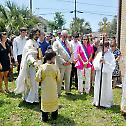Orthodox church enjoys triple celebration
GALVESTON — History isn’t really linear. Instead, it is marked by inflection points. These are places in time when the world seems to pivot around one moment, one person or one decision.
October A.D. 312 is one of these most singular moments. It was then, according to traditional teaching, when the Roman Emperor Constantine dished out a dramatic defeat to an enemy known as Maxentius in a battle just north of the eternal city. Before combat was joined, the young ruler was said to have seen the image of a cross in the dawning sky, along with the words, presumably in Latin, that set forth his future. The heavenly sky writing read, “In this sign you will conquer.”
And Constantine did just that. Soon after his victory, he legalized Sunday worship for Christians throughout his empire, helped the early church assemble its canon of scriptures and commanded it to consolidate one of its earliest and most enduring creedal statements. That is the Nicene Creed, which came out of an imperial church conference just 13 years later.
This emperor and his mother, Helen, were on the island last month — at least in a sense.
“They were our royal guests,” said the Rev. Serge Veselinovich, priest of Galveston’s Saints Constantine and Helen Serbian Orthodox Church.
He was speaking of the bejeweled displays, or reliquaries, which held small portions of bones from Constantine the Great and his mother, Empress Helen.
“We had a triple celebration here in June — Pentecost, Church Slava and the 116th anniversary of the consecration of our church on Sunday way back,” Veselinovich said.
The Slavic word “slava” refers to a patronal feast day. In this case, it honors the two saints from which Galveston’s historic Orthodox church draws its name. The “way back” refers to June 2, 1896, when the church was consecrated by a Russian bishop for its first 85 members.
As a port city, Galveston has long been a gathering point for world travelers. Thus, during the church’s first century, it has incorporated Greeks, Russians, Serbs and others of the Orthodox tradition.
But the church as we know it began with a local petition that made its way to the czar of all the Russias. His succinct, eight-word telegraphic reply was received by the faithful here. It read, “Let there be an Orthodox church in Galveston.”
Czar Nicolas financially supported the priest posted here until the 1917 Bolshevik Revolution ended the Russian monarchy.
Even further back in the story, while Constantine was moving the Roman Empire toward Christianity, his mother set off for Palestine on her own quest, according to traditional teaching.
“Empress Helena took a pilgrimage to the Holy Lands and discovered the true cross,” said Stephen Duncan, who is the church cantor.
So, for about 1,700 years, both mother and son have since traveled the Orthodox world as relics. Today, the island church that bears their name and hosted their visit remains a cosmopolitan mixture.
“Today, the most common language in our liturgy is English,” Duncan said. “But, Serbian, Greek, Russian, Church Slavic and Arabic are also used from time to time remembering the history and the various cultures which have contributed to this delightful, holy place.”
Source: http://galvestondailynews.com


